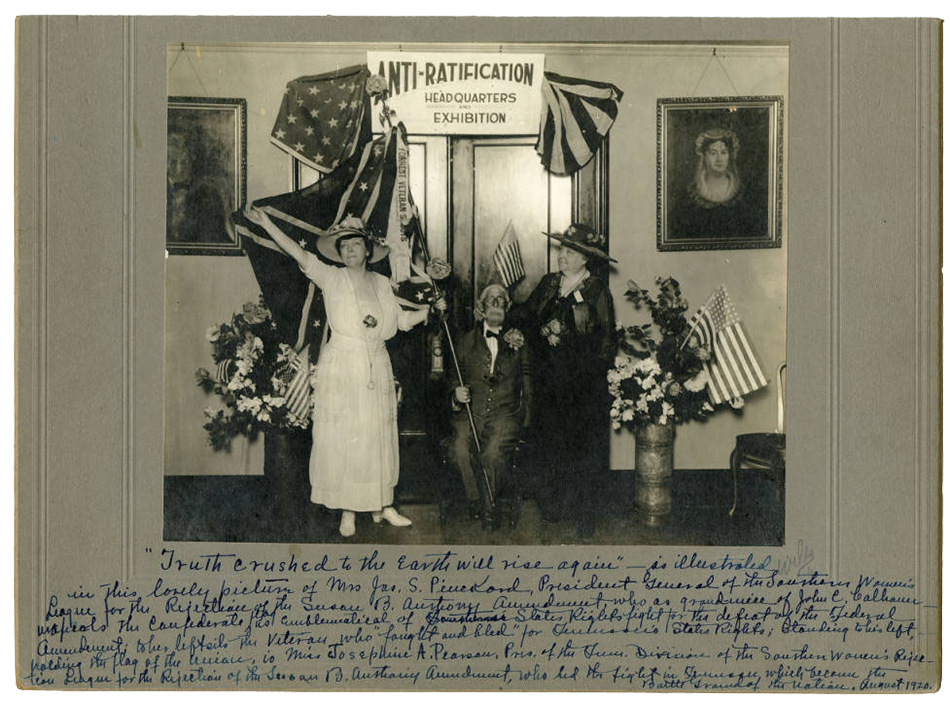Truth Crushed
Unknown. “Truth Crushed,” August 1920. Josephine A. Pearson Papers, 1860–1943. Tennessee State Library and Archives.
CAPTION TRANSCRIPTION
“Truth crushed to the Earth will rise again” — is illustrated in this lovely picture of Mrs. Jas. S. Pinckard, President General of the Southern Women’s League for the Rejection of the Susan B. Anthony Amendment, who as grand-niece of John C. Calhoun unfurls the Confederate flag as emblematical of Southerner’s States Right to fight for the defeat of the Federal Amendment; to her left is the Veteran who “fought and bled” for Tennessee’s States Rights; standing to his left, holding the flag of the union, is Miss Josephine A. Pearson, Pres. of the Tenn. Division of the Southern Women’s Rejection League for the Rejection of the Susan B. Anthony Amendment, who led the fight in Tennessee, which became the Battle Ground of the nation. August 1920.
Background
Nashville, Tennessee, was suffrage’s final battleground in August 1920. Thirty-six states needed to ratify the Susan B. Anthony Amendment (aka the woman suffrage amendment) to make it official, and thirty-five states had approved ratification as the Tennessee legislature began its debates. Suffragists and anti-suffragists from across the nation poured into the city. As legislators returned to the state capital after summer vacation, they were met in the train station, their offices, and other public places by women activists on both sides of the debate.
Anti-suffragists had reason to hope. Alabama, Georgia, Louisiana, Mississippi, North Carolina, South Carolina, and Virginia had all rejected ratification. For years, anti-suffrage had been closely tied to the ideology of the Confederacy, and the mythology of the Lost Cause placed significant emphasis on woman’s privileged role. White Southerners believed changes to womanhood threatened the Southern way of life and that empowering women through the vote—particularly Black and poor white women—was dangerous.
Suffragists were optimistic that Tennessee legislators would respond to the growing national momentum toward suffrage. They were right, but just barely. Tennessee approved ratification by just one vote. The Nineteenth Amendment passed.
About the Document
Josephine Pearson and Nina Pinckard led the anti-suffrage battle in Tennessee and posed for this photo outside their headquarters. The symbolism in this image ties anti-suffrage to the supposed honor and glory of the Old South. The women stand on either side of an elderly Civil War veteran. Nina holds a Confederate flag. Along the flagpole is a banner honoring Confederate general and Ku Klux Klan founder Nathan Bedford Forrest. Behind the women are portraits of Tennessean Andrew Jackson and his wife, Rachel.
Josephine Pearson included this photograph in a scrapbook and wrote the caption.
Vocabulary
- anti-suffrage: Opposing the expansion of the right to vote.
- Confederate Army: The army of the Southern Confederate states during the American Civil War.
- Ku Klux Klan: A white supremacy group formed by ex-Confederates after the Civil War that terrorized Black citizens and their supporters.
- Nineteenth Amendment: The constitutional amendment that declared the right to vote could not be denied on the basis of sex; it was ratified in 1920.
- ratification: The process by which an amendment to the federal Constitution is approved or rejected by states.
- suffrage: The right of voting; in this era, suffrage often referred specifically to woman suffrage, or the right of women to vote.
- Susan B. Anthony Amendment: The name of the Nineteenth Amendment before it was ratified.
- The Lost Cause: A false view of the Civil War that argues the war was fought over states’ rights, not slavery, and that the Confederate cause was about protecting the honor of the South.
Discussion Questions
- What symbols does this photograph include, and how does the photograph link anti-suffrage to the ideals of the Old South?
- In what ways does the caption convey how anti-suffragists argued against women’s suffrage?
- Shortly after this photograph was taken, the ratification of the Nineteenth Amendment defeated the anti-suffrage movement. Why is it still important to consider the anti-suffrage side and its losing argument?
Suggested Activities
- AP Government Connection: 4.4: Influence of Political Events on Ideology
- Learn more about the Lost Cause mythology and the particular role women played in promoting this white Southern ideology by analyzing this photograph in tandem with images of the Jefferson Davis Memorial, the life story of Janet Randolph, and additional resources in the curriculum Black Citizenship in the Age of Jim Crow.
- Consider this photograph in juxtaposition to the many Black suffragists within this unit, including Adella Hunt Logan, Fannie Barrier Williams, Ida B. Wells, and Mary Church Terrell.
Themes
POWER AND POLITICS
New-York Historical Society Curriculum Library Connections
- For more about Jim Crow racism and the Lost Cause mythology, see Black Citizenship in the Age of Jim Crow.







